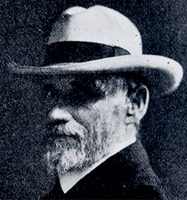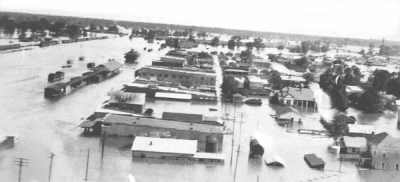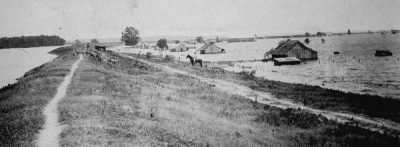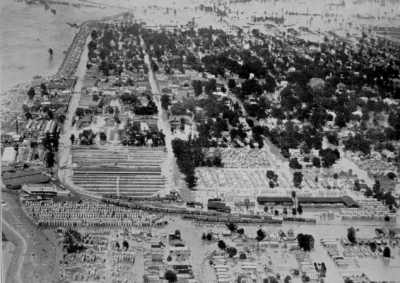 |
 |
| Home | Welcome | What's New | Site Map | Glossary | Weather Doctor Amazon Store | Book Store | Accolades | Email Us |
 | |||||||||||||||||
Dr Isaac M. ClinePart 3
|
|||||||||||||||||
 |
| Isaac Cline Photo Courtesy of NOAA/US Dept of Commerce |
One particularly useful area of expertise Cline brought to New Orleans was in flood forecasting. And living at the mouth of the Mississippi River gave him many opportunities to apply his expertise. He instituted a study of flood causes and conditions upon his arrival in the city for the purpose of delineating conditions that would cause flooding.
In early 1903, Cline had the opportunity to test his flood forecasting ability on the Father of Waters. Heavy rains in February presaged dangerous conditions on the river. On March 9th, Cline issued warnings of a coming record flood stage of 21 ft for the Mississippi in the next three to four weeks. He did so without the permission of the Chief of the Bureau.
Professor Harry C. Frankenfield, the Bureau official in charge of river and flood forecasting, ordered him to withdraw the warnings: "Deemed advisable for you to withdraw your warning for 21 feet until certain stage will be reached."
But Cline refused, insisting the warnings would save lives. "Is it not better to warn people of approaching disaster sufficiently in advance to enable them to prepare to meet it than to let them be caught unprepared," he responded.
"Approval of the warning was not received, my last telegram being ignored. This implied that the order to withdraw the warning for 21 feet must be obeyed." Cline then decided to ignore the order. "I was serving the public, so I disobeyed the orders from the Chief of the Weather Bureau by repeating the warning..." The river rose to 20.7 feet, but his actions again brought Cline in conflict with his superiors.
Nine months later, Cline received an official communication that his forecasts were not up to acceptable standards and as a result, he was being transferred to Honolulu. Only the intervention of the Louisiana congressional delegation saved him from the transfer.
Successful forecasts of flood levels in 1912 and of an approaching hurricane in 1915 saved many hundreds of lives. This hurricane possessed the highest wind velocities yet measured on the Gulf Coast: 140 mph. Storm tides of over 10 feet struck Lake Pontchartrain, Louisiana and Bay Saint Louis, Mississippi. Nearly every building in New Orleans sustained damage, but, given the magnitude of the storm, only 279 lives were lost, many of those at sea, thanks to the Bureau's storm warnings. The New Orleans Times-Picayune commented after the storm: "The intensity of the storm...proved the worthiness of Dr. I.M. Cline...Never before, perhaps in the history of the Weather Bureau, have such general warnings been disseminated as were sent out by the local bureau in reference to the disturbance that passed over New Orleans Wednesday evening." Cline was becoming a local hero in the Mississippi Delta.
In March 1913, Bureau Chief Moore resigned under pressure and replaced by Prof. Charles F. Marvin. On a visit to New Orleans, Marvin was shown a letter to Cline from Moore. In part it directed Cline to limit the forecasts of flood crests on the Mississippi River to ten days in advance of the expected peak. Marvin, according to Cline, responded: "Cline, you can disregard this letter and issue warnings for any period which you think will best serve public interest."
In 1926, Cline published his collected research on tropical storms in a book entitled Tropical Cyclones, which grew out of his long experience with hurricanes and other tidal phenomena. The Quarterly Journal of the Royal Meteorological Society reviewed it in 1930, saying: "This book constitutes a notable advance in the collection and representation of precise data with regard to the tropical cyclones of the North Atlantic Ocean, observed at coastal and inland stations of the American continent."
The final great achievement of Isaac Cline's professional career came in 1927. Conditions in
late 1926 and early 1927 indicated that the Mississippi Drainage Basin was in for severe
flooding. In fact, it would become one of the greatest floods in American history, changing the
fortunes of many individuals including giving a boast to Secretary of Commerce Herbert
Hoover's bid for the US Presidency in 1928.
 |
Photo Courtesy of NOAA/US Dept of Commerce |
Cline's skill as a forecaster was again brought to fore during this crisis. He successfully
predicted two weeks in advance the major stages of the Great Flood of 1927. But although Cline
was issuing the forecasts, the newspapers were not publishing his Flood Bulletins. Furious at
the snub, he called the reporters into his office and demanded to know why these warnings were
not transmitted to the public. The reporters replied they had written the stories but their
publishers refused to print them. They in turn had been pressured by a local censorship
committee who were afraid of the impact the bad publicity would have on New Orleans
commerce. Despite the greatest flood in history coming down the great river, few New Orleans
citizens even knew about the danger.
 |
Photo Courtesy of NOAA/US Dept of Commerce |
Cline threatened the committee: release the warnings through the press, or he would use other channels to distribute them. After some wiggling in their seats in an attempt to relieve themselves of total blame, the committee agreed to prominently post the warnings. As a result of his pressure, the New Orleans Item Tribune would print on July 3, an article entitled "Doctor Cline, Unsung Hero of Big Flood." In it, Secretary Hoover praised Cline's work: "Too much credit cannot be given Dr. Cline for the work he has done. His flood forecasts have been absolutely uncanny in their accuracy, he has without a doubt saved the lives of thousands of people with these bulletins."
At about the same time, Secretary Hoover commended Cline's work in a letter dated 5 July 1927 to Secretary of Agriculture William M. Jardine. It reads in part:
"There has been a service performed...which should be made a matter of illuminated record in your archives....Dr. Cline made a series of day to day estimates of the flood and its progress for over 2 months....We came to rely upon them and build the whole organization and direction of our rescue operation upon them....moreover the issue of this material to the public by Dr. Cline in such terms as to give confidence and understanding resulting in the saving of great life and property without any action on our part....It has been much more than the mere routine interpretation of the technical data. It required judgment and discretion which amounted to genius. He has been an honor to the Weather Bureau and the whole Department."
 |
Photo Courtesy of NOAA/US Dept of Commerce |
The Southern Pacific Lines later (November 23, 1927) also honored Cline, for his work during the flood with a plaque that read: "In recognition of distinguished service safeguarding lives and property of people and public interests of Louisiana during the disastrous Mississippi Valley flood of 1927. With precision of a wizard you foretold the points of danger and stages of approaching flood...." Early in 1928, the New Orleans Board of Trade, Association of Commerce, Cotton Exchange and New Orleans Steamship Association all honored Dr Cline's work during the flood.
Cline's remaining years with the Bureau were quiet in comparison but he remained popular with New Orleans residents. Locals used to watch Cline closely as he walked between his home in the French Quarter and the Bureau office to see if he carried an umbrella. Local lore attributes him with the adage: "Don't put rain in the forecast until it starts and don't take it out until it stops."
The legacy of his life's work was summarized when Tulane University of New Orleans, LA conferred an honorary Doctor of Science degree on Cline on June 6, 1934. The degree citation recognized his "exalted character, his eminent attainments in the science of meteorology, his constant devotion to truth and the welfare of society." It was only the third such honour bestowed in the institute's 100-year history.
Cline was also well recognized by his peers. He was elected a Fellow of the American Meteorological Society (and also served a term as its President), the American Geographical Society and the American Association for the Advancement of Science.
In 1935, Cline retired at age 75 from his official duties in the Weather Bureau after over 53 years of service. He was fond of saying, "I'm older than the Weather Bureau." Cline left a lengthy career in the U.S. Weather Bureau that was distinguished by his innovative forecasting, and his development of dissemination techniques, combined with outstanding public service efforts.
However, Cline was not content to "lead an idle, listless life--perhaps to die in a few years, as so many people do after retirement. The art knowledge which I had acquired opened a field in which I could occupy my time in a pleasant and profitable way, and at the same time keep myself in good mental health."
 In retirement, Cline opened a small art shop in New Orleans. His passion for art, particularly collecting Early American portraits and Chinese bronzes, had made him a wealthy man. His remaining spare time was filled at the easel, painting. He continued his meteorological work, however, publishing in 1942, a scientific monograph, A Century of Progress in the Study of Cyclones. He also wrote a personal memoir Storms, Floods and Sunshine: An Autobiography published originally in 1945 and reprinted in 2000.
In retirement, Cline opened a small art shop in New Orleans. His passion for art, particularly collecting Early American portraits and Chinese bronzes, had made him a wealthy man. His remaining spare time was filled at the easel, painting. He continued his meteorological work, however, publishing in 1942, a scientific monograph, A Century of Progress in the Study of Cyclones. He also wrote a personal memoir Storms, Floods and Sunshine: An Autobiography published originally in 1945 and reprinted in 2000.
Isaac Monroe Cline died on 3 August 1955 at the age of 93. Ironically, at the time of his death Hurricane Connie was gaining strength in the eastern Carribean. Eight days later, as Connie struck the Carolina coast pushing an 8 foot storm surge ahead of it, his brother Joseph also died.
Part 1: Dr Isaac M. Cline: The Early Years
Part 2: Dr Isaac M. Cline: Converging Paths: A Man and A Storm
For more information on Issac Cline and the 1900 Galveston Hurricane, see these articles:
The Weather Doctor--Weather Almanac, September 2000: Wasn't That A Mighty Storm?
The Weather Doctor--Weather Events: The 1900 Galveston Hurricane
The full text of Isaac Cline's storm report appeared in Monthly Weather Review (September 1900): Special Report on The Galveston Hurricane of September 8, 1900.
Reminescence of Cline on the early years of the US national weather service can be found at Personal View of Issac M. Cline.
Finally, The Weather Notebook has devoted three programs to the event: |
To Purchase Notecard, |
Now Available! Order Today! | |
 |
 |
NEW! Now |
The BC Weather Book: |


